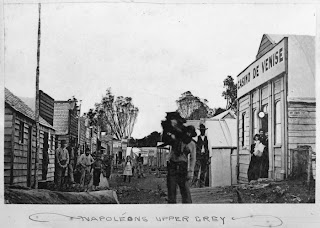On my father’s side of the family, we know our family-tree going back 8 generations from Hanna. In 5 of those generations there was someone called Hannah in the immediate family!
私の父方の家族の歴史は 羽菜から八代前までさかのぼることができます。 直系の家族の中だけでも5人の「はな」と呼ばれる先祖がいました。
5 generations before Hannah, my father’s family are descended from Hannah Graham (1845-1926), and William Taylor Smith. They married at Lyttleton, New Zealand in 1869.
羽菜の5代前、私の父方の家族のルーツはハンナ・グラハム(1845-1926)とウィリアム・テイラー・スミスに あります。 二人は1869年にニュージーランドのリトルトンで結婚しました。

Photo: William Taylor Smith and Hannah Graham. ウィリアム・テイラー・スミス と ハンナ・グラハム
Hannah and William are especially important in our family because they emigrated from England and Scotland and established our family in New Zealand.
ハンナとウィリアムの二人はイギリスとスコットランドから移住して、 ニュージーランドに家庭を築いたという点で私の家族にとって重要な人物です。
Hannah Graham was born in London, England in 1845. Her parents were William Graham (1809-1898) and Hannah Austin (1808-1849).
ハンナ・グラハムはイギリスのロンドンで生まれました。 両親はウィリアム・グラハム(1809-1898)と ハンナ・オースティン(1808-1849)です。

Photo: William Graham ウィリアム・グラハム(1809-1898)
William Graham’s profession was ivory turning. A turner is someone who makes things using a lathe. So he probably made ivory objects like thimbles, cups, chess pieces etc. Ivory was an expensive material so these would probably have been luxury items.
ウィリアム・グラハムの生業は象牙のろくろ師でした。 ろくろ師(旋削師)はろくろでものを作る職人です。 おそらく象牙で指貫やカップや将棋のこまを作っていたと思われます。 象牙は高価な材料だったので、これらは贅沢品だったことでしょう。

Photo: Turned ivory bottle. そくろく作った象牙のボトル。
William Graham’s family lived in London for 3 generations in the parish of St Luke’s, Old Street. Possibly in a house on Old Street itself.
ウィリアム・グラハムの家族は、かれの祖父の代からロンドンの聖ルーク・オールドストリートの教区に住んでいました。(教区は教会の区域です)。 たぶん彼の家はオールドストリートにありました。

Painting: St Lukes Church Old Street c 1810 by George Shepherd. View from the North East. Old Street runs behind the houses on the left. 聖ルークの教会・オールドストリート 1810ごろ. 北西から景色
The parish of St Lukes was outside the old London city walls north of ‘Moorgate’. It was originally an area of fields but between 1650 and 1850 the fields were gradually built over as London expanded. Several hospitals were built there so it became a fashionable area for doctors. Then from the beginning of the 19th century the area became more commercial and industrial, especially with the building of the City Road basin of the Regents Canal in 1820. So the doctors moved west to Harley Street. The area was badly bombed during the blitz and almost all the original buildings have been replaced by offices and apartment blocks.
聖ルーク教区の近所は ロンドン市の障壁の外で、 モーゲイトから北 の 所です。 もともと 牧草地でした. (「モーゲイト」は 平原にある門のことばで、昔の障壁の門でした。) 1650年から1850年までの間に、ロンドンが大きくなり、たくさんのビルが建ちました。 いくつかの病院も建ち、そこは医者にとってみりょく的な場所になりました。 しかし19世紀に入ると、商工業がさかんになりました。 たとえば1820年に レイジィントの運河と運河の「シテイロード」船着場 がたちました。そのため医者は西のハーレーストリートへ移りました。

Painting: St Lukes Church Old Street c 1810. View from the north east 聖ルーク教会・オールドストリート 1810年ごろ. 北東からの景色。
The church of St Lukes Old Street was built in 1732. William Graham’s parents were married there in 1791. His grandparents were also married at St Lukes, probably around 1765, and were buried there.
オールドストリートの聖ルーク教会は1732年に建てられました。 そこで ウィリアム・グラハムの両親は1791年に結婚しました。 祖父母も1765年ごろ聖ルーク教会で結婚して、 その教会に埋葬されました。

Painting: Sherpherdess Walk, Hoxton 1845. Looking south towards the City Road and St Luke’s. ホクストン 1845年 北から望む、聖ルーク教会の景色。
William Graham’s grandparents, James Graham (1740-1829) and Anne Filmer (1739-1805), may have originally come to London from villages in Kent. But we don’t have much information about their ancestors.
ウィリアム・グラハムの祖父母は ジェームス・グラハム(1740-1829) と アン・フィルマー(1739-1805) です。おそらくケントのある村からロンドンに移って来ましたが、彼らの先祖の情報が余り残っていないので詳しくはよくわかりません。
Our family have a story that James Graham had a famous uncle, although we can’t verify if this is true not. ‘Honest’ George Graham (1673-1751) was a clockmaker and member of the Royal Society. He invented several important designs for making clocks more accurate (the deadbeat escarpment and the temperature-regulated pendulum) and so made the most accurate clocks in the world at that time. He is buried in Westminster Abbey. He is called ‘Honest’ George Graham to distinguish him from the Arsenal football club manager of the same name.
本当かどうかはわかりませんが、ジェームス・グラハム には有名な伯父がいたと言われています。 それは 「堅実な」ジョージ・グラハムという 時計職人 で ロイヤルソサエテイーの会員でした。 彼は時計を作る上でのいくつかの大事なメカニズムを発明し、その当時で一番正確な時計を作り出しました。彼はウエストミンスター寺院に埋葬されています。
Painting: ‘Honest’ George Graham (1673-1751) 「堅実な」ジョージ・グラハム
Hannah Grahams mother was Hannah Austin (1808-1848). She was also born in London. Her maternal grandparents were Thomas Austin (1783-1831) from London and Hannah Oakley.
ハンナ・グラハムの母はハンナ・オースティン(1808-1849)です。 ロンドンで生まれました。 祖父母は ロンドンの トーマス・オースティン(1783-1831)と ハンナ・オークレイです。

Photo: Hannah Austin (1808-1849) in 1830. ハンナ・アウストン
William Graham and Hannah Austin married in 1830 at the Church of St Botolph’s. This church is just inside the old roman walls of London and was first built around 1000, although it was rebuilt in 1791.
ウィリアム・グラハムとハンナ・オースティンは 1830年に 聖ボトルフ教会で結婚しました。 この教会 は ロンドンの障壁の中で約1000年に建てられて、1791年に 建て直されました。

Picture: North-east view of St Boltoph, Aldersgate 1814, by John Coney. 聖ボトルフ教会 1814年。
Hannah Austin had 10 children with William Graham before she died in 1849 aged 40. Hannah Graham was the 9th child and was born 2-Aug-1845 in Camberwell, South London.
ハンナ・オースティンは1849年に40歳で亡くなるまでに10人の子供を生みました。 ハンナ・グラハムは 9人目の子供で、1845年8月2日に 南ロンドンのキャンバウェル で生まれました。

Picture: View of City Road Basin on Regent's Canal, Finsbury with barges on the canal. c1830. You can see the spire of St Lukes in the background. The Camberwell Basin near Hannah’s house in Camberwell would have looked similar. リージェント運河、「シテイロード」の船着場. 後ろの教会が聖ルークです。 「キャンバウェル」の船着場もおそらく同じような光景でしょう。
In the 1851 census Hannah’s family was recorded as living in South London at 5 Canal Place, Camberwell in South London. Canal Place was next to the Grand Surrey Canal, and near the Camberwell Basin, which would have been a commercial area of warehouses and workshops.
1851年の国勢調査の記録には ハナの家族の住所は 南ロンドンのカナル・プレース、5番地 キャンバウェル とあります。 カナル・プレースは グランド・サリー運河 に面し、キャンバウェルの船着場の近くでした。キャンバウェルの船着場は 倉庫と町工場が建ち並ぶの商業地帯 でした。

Painting: Surrey Canal, Camberwell, 1935 By Algernon Newton サリー運河、キャンバウェル, 1935年
The Surrey Canal and Canal Place no longer exist. In the 1970s the Surrey Canal was filled-in and the area was redeveloped into a new park called Burgess Park.
残念ながらサリー運河 と カナル・プレース という住所は現在では存在しません。 1970年ごろ サリー運河は埋め立てられ、新しく 「バゲス・パーク」 と呼ばれる公園になりました。

Photo: Burgess Park , 2005. Remains of Surrey Canal. バゲス・パーク 2005年 サリー運河の名残
In 1851, William Graham re-married Mary Anne. Soon after he sailed to New Zealand on the ship “Sir George Pollock” with his new wife and his seven surviving children, including Hanna Graham (aged 5).
1851年 ウィリアム・グラハムは 再婚しました。 新しい妻と 5歳のハンナ・グラハムを含む7人の残された子供達と共に 「サー・ジョージ・ポロック」号で ニュージーランドへ 出航しました。(*10人の子供のうち3人は幼い時に死亡)

Picture: Canterbury Association Ships in London. ロンドンの港に漂泊中のカンタベリー社の船
To be continued....
“The world begins to feel very small when one finds one can get half round it in three months” - Samuel Butler, 1860, on arrival in Lyttleton.
「3ヶ月で地球を半周できるようになって世界はとても小さくなったような感じがし始めた」サミュエル・バトラー (1860年にニュージーランドのリトルトンに到着)




.JPG)







































